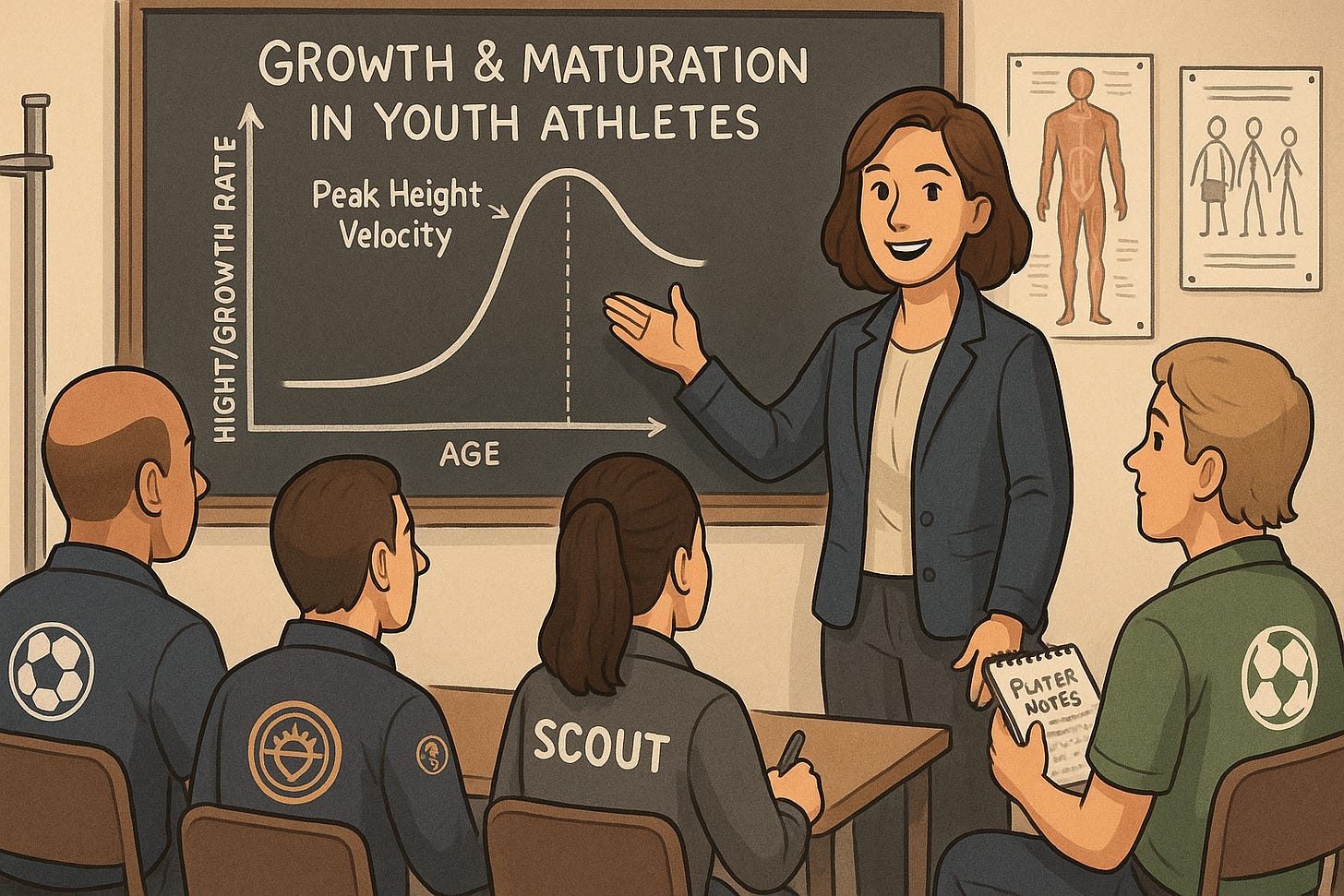Scouting Beyond Skill: Can a Growth & Maturation Workshop Impact Talent ID?
In the last post, a recent study of selection to the U14 Portugese national soccer squad was highlighted. It showed that 90% of those selected were early or on-time maturers, with the remaining 10% being late maturers.
Another recently published paper by Steve Curnyn as part of his doctoral work under the supervision of my great colleague Professor Sean Cumming, included 1,011 players from U10-U18 across 12 Scottish soccer academies. This is thought to be the largest sample to date to consider maturity biases in academy football. The results support the previous research on the topic indicating that a significant bias favouring early maturing players exists from U12 and it increases in magnitude with each age group.
Dr. Sean Cumming might have said it better during a recent presentation: What's more common, the Loch Ness Monster or late maturing boys in Scottish academy football?
Scouting Talented Young Athletes
Imagine you're a scout or coach, constantly on the lookout for the next big star. You see a player who's dominating the field. But what if that 'star' is just an early bloomer, whose physical advantage might level out as others catch up? And what about the smaller, less physically developed player who's incredibly skilled but currently overlooked?
Indeed, it is now well-known that being a biologically early maturer (especially boys) has a significant impact on a youngsters physical performance and likelihood of being selected to an “elite” or high level squad.
In doing so, many young talented athletes, especially late maturers, are left out and may either get lost in the system or vanish from it.
So, if this is the case - then what is one to do about it?
Raise Awareness
In a recent social media post, Professor Cumming commented that “the results have already prompted changes in the Scottish Football Association’s policy giving clubs more opportunity and flexibility to accommodate individual differences in growth and maturation.”
Although there is a lot of previous evidence on the maturity-related differences in physical performance abilities, sometimes it takes “proof of principle” on one’s home turf to really raise awareness. Seeing is believing.
Is Education the Solution?
How about educate key stakeholders including those who select for the high level squads?
This is exactly what David Johnson, currently the Head of Performance at West Ham United, did with a group of Premier League academy scouts.
Here is a summary of the study.
Purpose of the Study
The researchers (err, scholar-practitioner in the case of Dr. David Johnson) set out to evaluate how well soccer scouts can categorize young male players based on their maturational status (early, on-time, or late), and then determine if an educational workshop could improve their ability to do so.
Methods: What was done
Initial assessment of maturity: A week before the initial assessment by the 10 scouts, U13 and U14 academy squads were measured for height and weight. From these measurements, biological age was determined based on computed values from the Khamis-Roche method which were then compared to age- and sex-specific UK reference standards. Biological age minus chronological age (BA-CA) was used to categorize each player's maturity status: on-time (± 0.5 years), late if the difference was <-0.5 years, and early if the difference was > 0.5 years.
Scouts’ initial assessment: Without knowledge of the above assessment, scouts observed the players during typical training sessions, and categorized each player's perceived maturity timing as early, on-time, or late.
Educational workshop: Following this assessment by the scouts, a 45-minute educational workshop focusing on the physical changes in body size, physique, and appearance of males from childhood through adolescence. Crucially, it provided practical guidance on how to more effectively differentiate between early, on-time, and late maturing youth using an online quiz.
3-month follow-up: To gauge the workshop's impact, a follow-up questionnaire and on online quiz was distributed three months later, asking scouts to provide opinions on the workshop and also re-assess maturity timing.
Key Findings: What We Discovered
The results highlight the critical need for education in this area:
Initial Perception Gaps: Prior to the workshop, there was only limited agreement between the scouts' perceptions of player maturity timing and our objective assessments. This was particularly true for scouts who had no prior education in growth and maturation.
Significant Improvement Post-Workshop: The good news is that following the educational workshop, the agreement between the scouts' perceptions and the objective maturity timing assessments improved by a substantial 37%, moving from a "non-to-poor" level of agreement to a "fair" level.
Reduced Underestimation: Scouts generally tended to underestimate players' maturity timing. However, the workshop significantly reduced this bias: the percentage of players estimated as less mature than they actually were decreased by 64.5% in the post-workshop assessment.
Prior Education Matters: Notably, scouts who already had some previous education on growth and maturation (n=4) consistently demonstrated a greater level of agreement with objective assessments compared to their non-educated peers (n=4), both before and after the workshop. This suggests a foundational understanding is beneficial.
Take Home Message
These findings underscore the importance of targeted education in enhancing the accuracy of maturity timing identification among football scouts, potentially leading to a more nuanced and effective approach to youth talent development; however, further work is needed to make larger improvements.
🔗 Link to the full paper: D Johnson et al. The impact of maturation education on scouts’ ability to assess maturity. Sport Perf Sci Report October, 2024
Related reads: Freebies
Why College Coaches Need to Understand Growth & Maturation
Fool’s Gold and Diamonds in the Rough: The Adolescent Growth Spurt in Boys
Navigating Growth & Maturation in Youth Sports: An Audio Overview
Paid content: 🔒 Subscribers Only
The Adolescent Growth Spurt: Video Lecture
The Influence of Maturation on Physical Performance during Adolescence: Video Lecture



